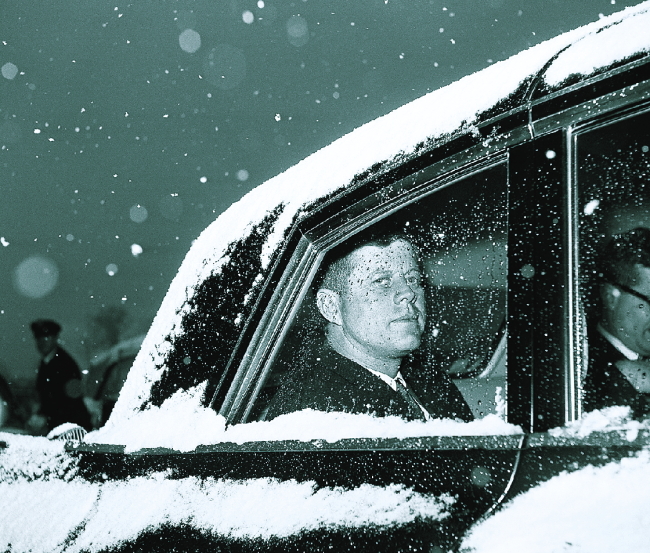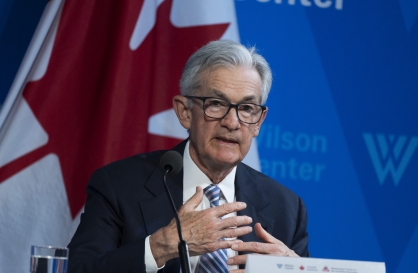When we think of John F. Kennedy, we can’t help but bring to mind images of his assassination, but if there’s anything surprising about the 50th anniversary of his killing, it is the books that look back at his life.
That may be because there’s no new ground to be broken on the assassination, although Life magazine’s magnificent “The Day Kennedy Died” (Life Books: 192 pp.) does offer a lavish retrospective that takes us through the tragedy, ending with the president’s funeral.
There is perspective (a chapter on conspiracy theories) and nostalgia (a reprint of the Nov. 29, 1963, issue of the magazine). Best of all is a gatefold featuring every frame of the Zapruder film in sequence, accompanied by an essay offering commentary from Zapruder’s granddaughter, Alexandra, who is working on a book about the family and the film.
That may be because there’s no new ground to be broken on the assassination, although Life magazine’s magnificent “The Day Kennedy Died” (Life Books: 192 pp.) does offer a lavish retrospective that takes us through the tragedy, ending with the president’s funeral.
There is perspective (a chapter on conspiracy theories) and nostalgia (a reprint of the Nov. 29, 1963, issue of the magazine). Best of all is a gatefold featuring every frame of the Zapruder film in sequence, accompanied by an essay offering commentary from Zapruder’s granddaughter, Alexandra, who is working on a book about the family and the film.

Larry J. Sabato’s “The Kennedy Half Century: The Presidency, Assassination, and Lasting Legacy of John F. Kennedy” (Bloomsbury: 606 pp.) gives a lot of space to the assassination, but to call it an assassination book is to miss the point. Rather, it’s an in-depth look at the role of the killing in cementing his memory as an American martyr, invoked by politicians of both parties over the half-century since. Sabato uses Kennedy as a lens through which to examine contemporary history, in which image is as essential as policy.
“For Democrats, he is in the permanent pantheon of party saints,” he writes, although “many modern Democrats have forgotten just how conservative many of JFK’s policies were.”
Kennedy’s conservatism is at the core of Ira Stoll’s “JFK Conservative” (Houghton Mifflin Harcourt: 262 pp.), which argues that its subject has been misunderstood. I’m not so sure about that; yes, he’s lionized as a liberal hero, but he was a hawkish anti-communist who increased our commitment in Vietnam.
On the domestic side, he urged a slow approach to civil rights, so much so that Jackie Robinson supported Richard Nixon in the 1960 campaign. Stoll presents a sober argument, taking us through domestic and foreign issues, although the Kennedy he portrays seems less conservative than cautious, aware of the limitations and uses of his power.
A similar vision emerges in John T. Shaw’s “JFK in the Senate: Pathway to the Presidency” (Palgrave Macmillan: 228 pp.), a study of Kennedy’s Senate career, which he regarded as something of a training ground. The seeds of much of his presidency can be found here, from his sense of the necessity for engagement in Southeast Asia to his use of the Senate to strengthen relationships and create a national platform, a strategy he consolidated at the 1956 Democratic Convention, where he narrowly missed being selected as Adlai Stevenson’s running mate, and with the publication a year later of “Profiles in Courage,” which won a Pulitzer Prize.
Robert Dallek’s “Camelot’s Court: Inside the Kennedy White House” (Harper: 492 pp.) addresses what happened once Kennedy assumed the Oval Office, through the filter of the “Ministry of Talent” (his brother Bobby, Secretary of State Dean Rusk, Secretary of Defense Robert McNamara, Ted Sorensen, Arthur Schlesinger) with whom he surrounded himself. It’s a story that’s been told before ― by Dallek, even, in his 2003 biography “An Unfinished Life: John F. Kennedy, 1917-1963” ― but here it takes on a fascinating focus, framed by the 1,000 days of JFK’s presidency.
Kennedy’s presidency also helps frame “The Letters of John F. Kennedy,” edited by Martin W. Sandler (Bloomsbury Press), which is, remarkably, the first collection of his letters to be compiled. I say remarkably because, like Barack Obama, Kennedy was a president who knew how to express himself on the page.
The letters here run from personal to presidential, trivial to profound. At their best, they capture his personality, his sense of style and humor, as in the 1962 telegram he sent to the American Booksellers Assn. on the occasion of its annual convention, noting his regrets at not being able “to join you in person in order to discuss the inadequacy of the sales” of his first book, 1940’s “Why England Slept.”
By David L. Ulin (Los Angeles Times)
“For Democrats, he is in the permanent pantheon of party saints,” he writes, although “many modern Democrats have forgotten just how conservative many of JFK’s policies were.”
Kennedy’s conservatism is at the core of Ira Stoll’s “JFK Conservative” (Houghton Mifflin Harcourt: 262 pp.), which argues that its subject has been misunderstood. I’m not so sure about that; yes, he’s lionized as a liberal hero, but he was a hawkish anti-communist who increased our commitment in Vietnam.
On the domestic side, he urged a slow approach to civil rights, so much so that Jackie Robinson supported Richard Nixon in the 1960 campaign. Stoll presents a sober argument, taking us through domestic and foreign issues, although the Kennedy he portrays seems less conservative than cautious, aware of the limitations and uses of his power.
A similar vision emerges in John T. Shaw’s “JFK in the Senate: Pathway to the Presidency” (Palgrave Macmillan: 228 pp.), a study of Kennedy’s Senate career, which he regarded as something of a training ground. The seeds of much of his presidency can be found here, from his sense of the necessity for engagement in Southeast Asia to his use of the Senate to strengthen relationships and create a national platform, a strategy he consolidated at the 1956 Democratic Convention, where he narrowly missed being selected as Adlai Stevenson’s running mate, and with the publication a year later of “Profiles in Courage,” which won a Pulitzer Prize.
Robert Dallek’s “Camelot’s Court: Inside the Kennedy White House” (Harper: 492 pp.) addresses what happened once Kennedy assumed the Oval Office, through the filter of the “Ministry of Talent” (his brother Bobby, Secretary of State Dean Rusk, Secretary of Defense Robert McNamara, Ted Sorensen, Arthur Schlesinger) with whom he surrounded himself. It’s a story that’s been told before ― by Dallek, even, in his 2003 biography “An Unfinished Life: John F. Kennedy, 1917-1963” ― but here it takes on a fascinating focus, framed by the 1,000 days of JFK’s presidency.
Kennedy’s presidency also helps frame “The Letters of John F. Kennedy,” edited by Martin W. Sandler (Bloomsbury Press), which is, remarkably, the first collection of his letters to be compiled. I say remarkably because, like Barack Obama, Kennedy was a president who knew how to express himself on the page.
The letters here run from personal to presidential, trivial to profound. At their best, they capture his personality, his sense of style and humor, as in the 1962 telegram he sent to the American Booksellers Assn. on the occasion of its annual convention, noting his regrets at not being able “to join you in person in order to discuss the inadequacy of the sales” of his first book, 1940’s “Why England Slept.”
By David L. Ulin (Los Angeles Times)








![[Today’s K-pop] BTS pop-up event to come to Seoul](http://res.heraldm.com/phpwas/restmb_idxmake.php?idx=644&simg=/content/image/2024/04/17/20240417050734_0.jpg&u=)
![[Graphic News] More Koreans say they plan long-distance trips this year](http://res.heraldm.com/phpwas/restmb_idxmake.php?idx=644&simg=/content/image/2024/04/17/20240417050828_0.gif&u=)






![[KH Explains] Hyundai's full hybrid edge to pay off amid slow transition to pure EVs](http://res.heraldm.com/phpwas/restmb_idxmake.php?idx=652&simg=/content/image/2024/04/18/20240418050645_0.jpg&u=20240419100350)

